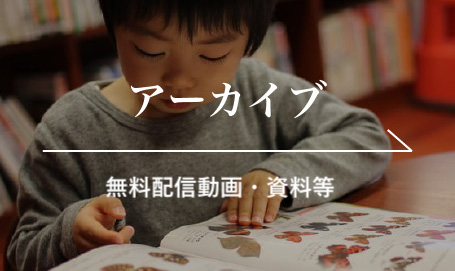< VOLUME 44, No.1 >
Hagiwara Motoaki. Children in the Community.
Research on Early Childhood Care and Education in Japan, 2006, 44(1), 12-21.
Children’s life and play in their community have changed according to changes within the community. Historical changes in the community affected children and parents’ behaviors. This study examined various problems of children in the community focusing on the relationship between children and adults’: children and parents, children and neighbors, and children and nursery teachers. It is necessary for adults to accommodate psychological needs of each child in the community to solve those problems. The author introduces some models of an open system of child care in the community to help resolve children’s problems.
Keywords: community, accommodation, an open system of child care in the community
—————–
Murayama Yuuichi. Children in a Community and Tasks of Kindergartens and Day Nurseries : Widening of the Environmental Gap of Child Care and Promotion of Unified Child Welfare Administration.
Research on Early Childhood Care and Education in Japan, 2006, 44(1), 22-29.
Fifteen years have passed since child care support policies such as the “Angel Plan” were implemented in Japan. However, the child care situation has been getting more problematic while the birthrate has continued to decrease. Parents’ consciousness and distress about child care depend on their environment. This study analyzed how the environmental gap of child care had become widened. The result suggests that it is necessary to recognize parents’ various thoughts and needs, and promote child care policies within a community. Better understanding of Child Welfare Law and its comprehensive, fundamental nature will help to promote unified child welfare administration. Kindergartens and day nurseries have an important role in fostering child care support in every community. It is necessary to expand the function of kindergartens and day nurseries to facilitate daily communication between parents and teachers, which is an essential basis for improved child care.
Keywords: child care support, an environmental gap of child care, the Child Welfare Law, unified child welfare administration, communication between parents and teachers, kindergartens and day nurseries
—————–
Sakurai Chieko. The Appearance of the Point : “Children in a Local Community” in Family Education Policy.
Research on Early Childhood Care and Education in Japan, 2006, 44(1), 30-38.
This study analyzed the annual transition of “Family Education Seminar Report” to examine how “local community” had come to be recognized in Japan after World War II and what kind of function of local community is necessary for children’s growth and development. In the beginning, the role of parents for children’s growth was discussed mainly in terms of family education policy. However, a problem of “child care by alienated mothers” became a new topic of concern. The concept of “local community” was introduced to the discourse after an international seminar in 1983 at which Prof. Hiroko Hara, the leader, focused on the meaning of local community as “an association among neighbors” and observed that the result of WMS research showed that children expressed more trust in their neighbors than in their parents. This finding suggested that neighborhood women have an important role in fostering healthy growth in children in a community. It also points out the necessity of creating a local community in which free and open association is possible between children and neighbors.
Keywords: local community, children’s growth and development, family education, association with neighbors
—————–
Kondo Mikio. The Relation between the Characteristics of Local Community and Child Care : Historical Problems of a Day Nursery for Children under Three in “K” Village Known for Highland Vegetable Production.
Research on Early Childhood Care and Education in Japan, 2006, 44(1), 39-49.
“K” village in Nagano Prefecture is known for its production of highland vegetables. A public day nursery in K village has been engaged in caring for children three and over while another private day nursery has taken care of children under three. This study analyzed the 17 year history of the private day nursery and the actual working situations of their parents. Results of the research indicated that demand for care of children under three had increased. The actual situation of labor and women’s lives in the village included the following forms of child care: centers for under three open only during the busy farming season, year round child care for self-employed people and workers, and support for parenting during the farming off-season. The parents’ active movement in the care of their children under three in K village evolved into a new stage in 2005. The local situation showed the tasks of child care in K village and at the same time child care efforts had a role in building a local community.
Keywords: a village known for highland vegetable production, children under three, building a local community
—————–
Nakatani Natsuko. A Study on Children’s Play Space and a Mother’s Child-rearing Anxiety : Focus on Mothers’ Networks for Child-rearing and Experiences in Mothers’ Families of Orientation.
Research on Early Childhood Care and Education in Japan, 2006, 44(1), 50-62.
This study examined what kind of play spaces mothers have given children, how those play spaces were related to their child-rearing anxiety, what kind of differences existed between a mother with many play spaces and a mother with few play spaces in terms of their anxiety, their networks for child-rearing, and their experience of “family of orientation”. The result indicated that mothers with many play spaces tended to have less anxiety, more networks for child-rearing and richer experiences in their “family of orientation” than mothers with few play spaces. It was considered that the intergenerational transmission of child-rearing is reflected. It also suggested that the number of children’s play spaces reflected transmission of knowledge of child-rearing influenced.
Keywords: children’s play space, child-rearing anxiety, network for child-rearing, family of orientation, childcare support
—————–
Inoue Hisami. Problems and Possibilities on Cooperative Efforts between Pre-entry School Education and Post-entry School Education : Report on a Case Study of Childcare.
Research on Early Childhood Care and Education in Japan, 2006, 44(1), 63-72.
It is necessary that the transition from “Pre-entry School education” to “Post-entry School education” occurs smoothly. This study analyzed arguments regarding childcare for buraku liberation in Osaka from 1970’s to 1990’s to find out a clue to solving the current problems of cooperative practice. The previous discussion indicated three important points: exchange of information focusing on children’ growth, consistency of curriculum, and understanding of practice considering differences. The result of this study suggested five necessary viewpoints for better cooperative practice: detailed description, inclusion of the perspective of the child, conservation of the rights of privacy, curriculum based on actual situations, and acceptance of uncertainty.
Keywords: cooperative practice, pre-entry School education, post-entry School education, childcare for buraku liberation
—————–









